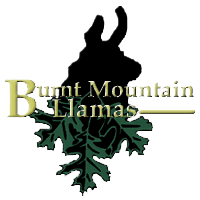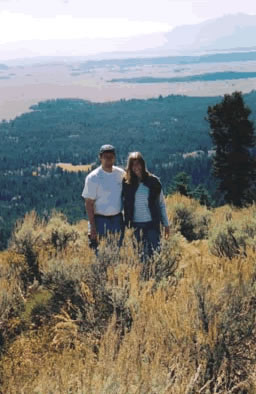

This picture was taken during our visit to Grand
Tetons National Park.

(C) Copyright Burnt Mountain Llamas,
2001 .
Artwork by Jennifer White.
Who We Are
We are Jim, Jennifer, and Arianna White, owers of Burnt Mountain Llamas. We are currently located in the Shenandoah Valley, near Mount Solon, Virginia, about twenty minutes from Harrisonburg and 15 minutes from Staunton. We recently moved to the 26 acre farm where we will begin to expand our herd numbers. We enjoy working with llamas and the sense of enjoyment we get from raising them to share with others. Virginia is a great state to raise llamas, and we have met some great people and friends through the mutual interest we have in llamas.
How It All Started
One night we were watching a television show about a bed and breakfast business in Alaska that had llamas. Jim joked about getting one to have at the property we had recently bought. Naturally it seemed weird and Jen was not interested. What started out as a joke became serious consideration when Jim decided to find out more about llamas the next day on the internet. The more he read and saw how magnificent llamas are, the more he was sure he wanted two (the minimum suggested). That curiosity led to what is now Burnt Mountain Llamas. Jen got interested about 4-5 days after Jim, and we bought our first llama less than two months later.
Our Current Occupations And Other Pets
We moved to Charlottesville, VA in 1999 after living in Maryland for several years. Jim now works in a microbiology lab at Merck & Company and has a masters degree in biology. His area of expertise is in molecular biology, as well as a solid background in genetics. Jen currently stays home with daughter, Arianna, who is now three. We have five cats, one cockatiel, and a Bernese Mountain dog (Gracie), and of course, the llamas. Jim also runs LlamaSalesList.Com , LlamaBreeder.Com, LlamaSeeker.Com, and AlpacaSalesList.Com . Jim also designs web sites for people, as time permits.
Our Farm
The farm consists of a 80' x 40' barn with 8 stalls that can be combined as needed, a 30' x 20' maternity stall, a wash room complete with heating/cooling or sick animal isolation, a work area, tack/feed room, office, and a hay loft capable of holding 500-600 bales of hay. We also have set aside laboratory space for some camelid studies. The barn meets our immediate and future needs quite easily. We currently use about 15 acres of the 26 acres we own.
Our Breeding Philosophy and Goals
To have a good breeding program, understanding genetics is key, as well as carefully selecting animals that fit your goals. We always want to breed the best of what we have. Through previous crosses we and others have done, we can gain some insight to genetics of individual llamas without actually knowing much about the genes that cause these phenotypes. This was a big factor in acquiring Merit. What good is a herd sire that cannot produce great offspring? Merit's desirable traits are consistently shown in his offspring. In terms of dominant and recessive genes, Merit's genes appear to be dominant over most female's genes. The quality of the herd sire is without doubt extremely important and can influence up to 50% of the herd's genetics. In our opinion, the quality should be matched in the breeding females. Fifty percent of an individual offpsring's genetic makeup will come from the female. Some of these genes will be dominant and some recessive to the male's. While no llama is perfect, we will breed the best females we can. Therefore, we have very stringent criteria for any females we buy, and we try to match strengths and weaknesses in hopes of obtaining a better animal.
As time goes on, we see our breeding philosophy evolving as we refine our goals and interests. Currently, here are our basic goals:
-
Establish a herd of 30-50+ llamas.Produce offspring that do well in the show ringBreed and raise healthy llamas with good dispositions, outstanding fiber, great conformation/correctness, and presence (all of these qualities are equally important to us).We are interested in producing llamas with abundant fleece.To breed for quality, not quantity. We want to produce the best llamas we can, and it is important that we look at our breeding stock and determine which combinations will help us reach our goals. Our herd will continue to increase, but not at the sacrifice of quality. This is one reason our herd has grown slowly thus far.We will breed what we like and stay away from what we don't like. We choose our llamas by what appeals to us and will help us achieve our goals. We do believe diversity is good, but above all, we pick llamas for their individual appearance and their potential to help us reach our goals.
-
To offer great llamas for sale both off the farm and at well known llama auctions.
Argentine, Chilean, Bolivian, and North American bloodlines are all represented in our herd.We invite you to meet our llamas with a farm visit.
Jim and Jen White, Burnt Mountain Llamas, October 2008